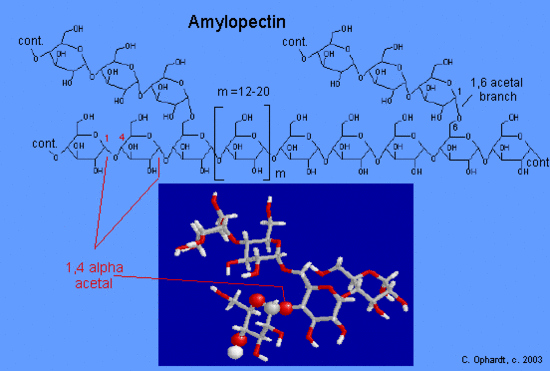Starch
- Page ID
- 396
Polysaccharides are carbohydrate polymers consisting of tens to hundreds to several thousand monosaccharide units. All of the common polysaccharides contain glucose as the monosaccharide unit. Polysaccharides are synthesized by plants, animals, and humans to be stored for food, structural support, or metabolized for energy.
Introduction
Plants store glucose as the polysaccharide starch. The cereal grains (wheat, rice, corn, oats, barley) as well as tubers such as potatoes are rich in starch. Starch can be separated into two fractions--amylose and amylopectin. Natural starches are mixtures of amylose (10-20%) and amylopectin (80-90%).

Amylose forms a colloidal dispersion in hot water, while amylopectin is soluble it is demanding of more extensive heating than amylose. The structure of amylose consists of long polymer chains of glucose units connected by an alpha acetal linkage. The graphic on the left shows a very small portion of an amylose chain. All of the monomer units are alpha -D-glucose, and all the alpha acetal links connect C #1 of one glucose and C #4 of the next glucose.
Acetal Functional Group
Carbon # 1 is called the anomeric carbon and is the center of an acetal functional group. A carbon that has two ether oxygens attached is an acetal. The Alpha position is defined as the ether oxygen being on the opposite side of the ring as the C # 6. In the chair structure this results in a downward projection. This is the same definition as the -OH in a hemiacetal.

As a result of the bond angles in the alpha acetal linkage, amylose actually forms a spiral much like a coiled spring. Amylose is responsible for the formation of a deep blue color in the presence of iodine, which slips inside of the amylose coil.
Amylopectin
The graphic on the left shows very small portion of an amylopectin-type structure showing two branch points [drawn closer together than they should be]. The acetal linkages are alpha connecting C #1 of one glucose to C #4 of the next glucose.

The branches are formed by linking C #1 to a C #6 through an acetal linkages. Amylopectin has 12-20 glucose units between the branches. Natural starches are mixtures of amylose and amylopectin. In glycogen, the branches occur at intervals of 8-10 glucose units, while in amylopectin the branches are separated by 10-12 glucose units.
Contributors
Charles Ophardt (Professor Emeritus, Elmhurst College); Virtual Chembook

